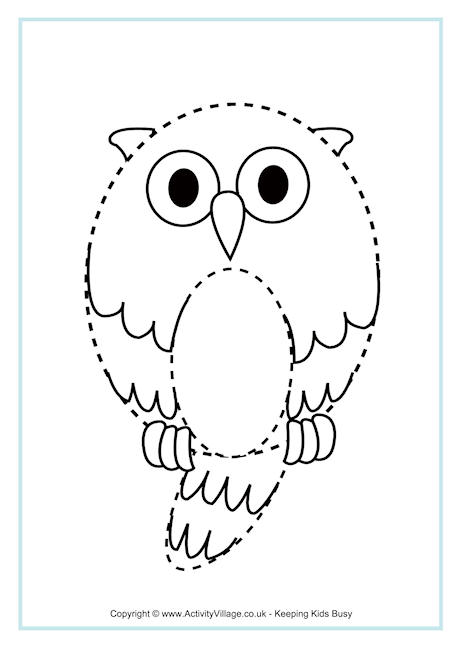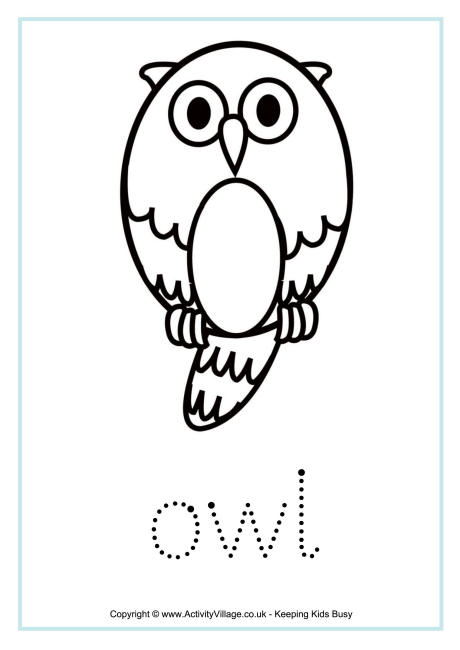Owl Tracing
Owls, the nocturnal birds that we often associate with wisdom, are a popular subject in early childhood education. One activity that is especially popular is owl tracing, which helps children develop fine motor skills and hand-eye coordination.
The Pain Points of Owl Tracing
Many parents and teachers struggle with finding activities that engage young children and help them develop important skills. Owl tracing can be a fun and educational activity, but some children may find it challenging to hold a pencil or stay focused on the task at hand.
What is the Target of Owl Tracing?
The target of owl tracing is to help young children build their fine motor skills and hand-eye coordination. By practicing tracing lines and shapes, children develop the small muscles in their hands that they will need for writing and other activities. Tracing also helps children learn to control their movements and stay focused on a task for a longer period of time.
Summary of Key Points
Owl tracing is a beneficial activity for young children's development. It can help them build fine motor skills and hand-eye coordination, as well as improve their ability to focus on a task. By practicing tracing lines and shapes, children will be better prepared for writing and other activities that require precise hand movements.
Owl Tracing and Its Target
When my daughter started preschool, one of the first things she learned was how to trace different shapes and lines, including owls. At first, she found it challenging to hold the pencil correctly and stay focused on the task. However, with practice, she improved her fine motor skills and hand-eye coordination.

Tips for Successful Owl Tracing
If you want to help your child get the most out of owl tracing activities, here are some tips to keep in mind:
- Provide plenty of opportunities to practice, but keep sessions short to avoid frustration.
- Invest in pencils or crayons that are easy for young children to hold.
- Make sure the tracing lines and shapes are large enough for small hands to handle.
- Provide positive reinforcement and encouragement to keep your child motivated.
The Importance of Fine Motor Skills
Developing fine motor skills is a critical part of a child's early development. These skills enable children to perform tasks that require precise hand movements, such as writing, drawing, and using scissors. Activities like owl tracing help children build the small muscles in their hands, improving their dexterity and control.

The Benefits of Hand-Eye Coordination
Hand-eye coordination is the ability to synchronize the movement of the hands and eyes to perform a specific task. This skill is essential for everyday activities like catching a ball, pouring a drink, and using a keyboard. Owl tracing can help children improve their hand-eye coordination by requiring them to coordinate their hand movements with what they see on the paper.

My Experience with Owl Tracing
As a parent, I have found that owl tracing is an excellent way to help my daughter develop her fine motor skills and hand-eye coordination. It's also a fun activity that she enjoys doing, which makes it easier to keep her engaged and motivated. By practicing tracing lines and shapes, she is learning skills that will help her succeed not just in school, but in life.
Question and Answer
Q: At what age should children start owl tracing?
A: Owl tracing is a great activity for children as young as three years old. At this age, children are developing their fine motor skills and hand-eye coordination, making it an ideal time to start.
Q: Are there any safety concerns with owl tracing?
A: When your child is using pencils or other writing tools, make sure they are supervised and that the tools are age-appropriate. Also, ensure that the child does not put objects in their mouth or nose while tracing.
Q: How often should children practice owl tracing?
A: It's a good idea to provide plenty of opportunities for your child to practice owl tracing, but keep sessions short to avoid frustration. For young children, 10-15 minutes per day is sufficient.
Q: What are some other activities that can help develop fine motor skills?
A: Other activities that can help develop fine motor skills include playing with blocks, stringing beads, and cutting with scissors. Drawing and coloring are also great ways to improve hand-eye coordination and fine motor skills.
Conclusion of Owl Tracing
Owl tracing is a fun and educational activity that can help young children develop important skills. By practicing tracing lines and shapes, children can improve their fine motor skills, hand-eye coordination, and ability to stay focused on a task. With plenty of opportunities to practice and positive reinforcement, children can gain important skills that will help them succeed in school and beyond.
Gallery
Winter Pre-writing Tracing Owl Tracing Lines Pre-Writing For Pre-K

Photo Credit by: bing.com / tracing
Owl Word Tracing
Photo Credit by: bing.com / owl tracing word worksheet activity worksheets printables village explore animals
10 Printable Fall Tracing & Handwriting Worksheets! | Handwriting

Photo Credit by: bing.com / worksheets owl tracing preschool drawing handwriting printable printables fall practice writing pages letter sheets kids mpmschoolsupplies improve easy
Owl Tracing

Photo Credit by: bing.com /
Winter Pre-writing Tracing Worksheets : Owl Tracing Activities | Winter

Photo Credit by: bing.com / tracing
